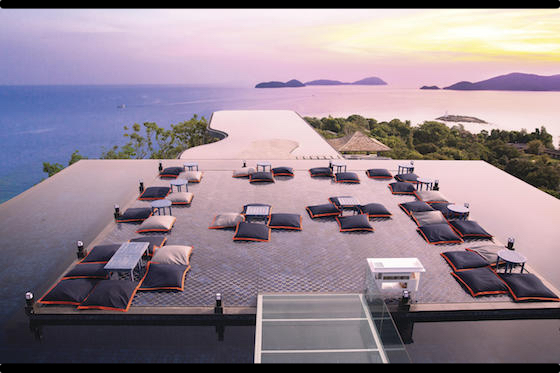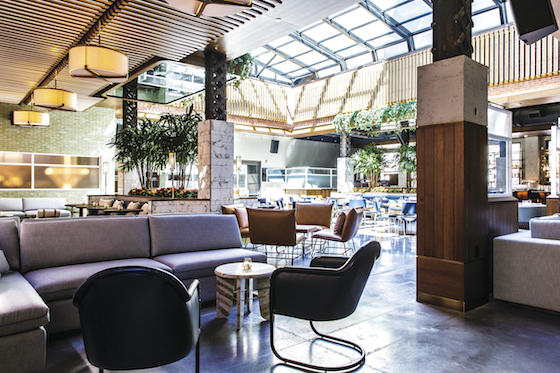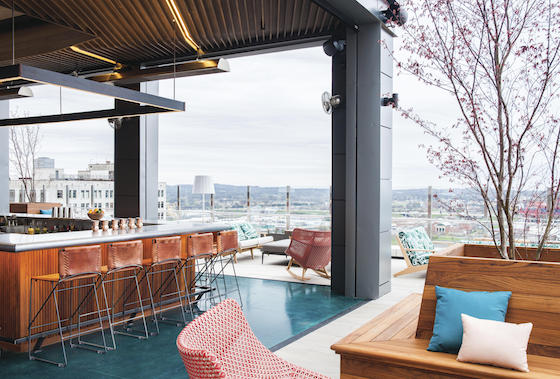This musing from F&B consultant Guy Rigby pretty much sums up the catch 22 of rooftop restaurants:
“They’re very popular, and if you can get them right, they can be good money-makers. If you get them wrong, they can be a huge problem,” says Rigby, president and founder of Toronto-based Octopus. Indeed, of the handful of global hotel rooftop bar operators HOTELS spoke with, rooftop restaurants were, on average, making up 30% to 35% of overall annual F&B sales at the property level.
Know your clientele
Bringing in that kind of revenue means differentiating your rooftop and being smart about targeting the right kind of guests, Rigby says.

Take Skye Bar at Hotel Unique in São Paulo, Brazil. The restaurant, run by chef Emmanuel Bassoleil, has 70 seats with another 120 at the bar and overlooks a red-lit swimming pool. The menu angles toward an international audience with items like bass with Champagne and caviar and the “famous” PF risotto.
“Since its opening, we thought that Skye would have good acceptance, but since its first day, the movement exceeded our expectations,” says Wellington Melo, the property’s director of operations. “At the beginning, we intended to serve from 150 to 200 customers per day, but for 16 years, since its inauguration, we have been serving from 500 to 600 customers every night.”
But it isn’t all caviar and Champagne. The bar offers a different, more appetizer-focused menu with calzones, pizzas and Japanese offerings. And partially, it’s that ability to tap into multifaceted clienteles (and give them what they need) that can make or break rooftop F&B.
Look at Chicago’s Kimpton Gray — its rooftop restaurant Boleo opened along with the property in 2016 and has a South American and Argentinian culinary focus. While the regional focus is the same, the restaurant’s new chef, Cory Morris, who joined in September 2017, says he has learned to adapt recipes to resonate with one of Boleo’s main clienteles: the happy hour business district crowd. Morris’ first big change to the menu was to alter a very authentic anticucho de corazon (beef heart marinated in a corazon sauce) by subbing out the heart for steak.
“People are afraid of beef heart. And so I thought, let’s look at our crowd and let’s try it with a grass-fed skirt steak and see how it sells,” he says. “And instantly it was our number one seller because people love skirt steak. We’re still cooking with the authentic flavors, but we’re also cooking to our guest and giving them what they want.”
Key, too, is keeping the menu small (17 items) as much of the revenue is coming in through Boleo’s cocktail program. At 4,000 square feet, the rooftop restaurant is also able to accommodate larger corporate meetings and weddings. Though Morris says he could use more back-of-house space, he says the lack of it forces him to keep ingredients as fresh as possible. Morris estimates that out of some US$6 million F&B sales for the Kimpton Gray (including two other outlets and banquet sales), Boleo is on track to contribute US$3 million of that.
“We’re blowing it out of the water,” he says.

Blowing past limitations
“Hoteliers must also think through not only the sense of arrival, but access of staff so (the rooftop restaurant) is operationally efficient,” Rigby adds. It pays, he says, to have a service elevator that goes directly to the rooftop as well as an elevator that offers direct rooftop access for clientele not staying with the hotel.
And while a view can be nice, the property shouldn’t rely on that element alone.
“Is the view going to be interesting at night? It’s great to put these things in a resort, but honestly, by the time the sun goes down, which is the time when people are going to go to the rooftop bar, then in the evening there’s nothing to look at,” Rigby says.
Sri Panwa Phuket’s Baba Nest in Thailand need not worry about the view, but it does have to manage limited seating. A maximum 50 people can sit on the rooftop, which has 360-degree ocean views for guests who can sit on cushions at 12 short tables and be served Mexican-style tapas.
“Because it’s on our rooftop and a high building with nothing obstructing (the view), it’s best to have short seating rather than high chairs for guests’ safety and to make it more comfortable,” says Pimkan Kongsanoon, who runs business development for the property.
Due to the limited seating, reservations are strongly encouraged and the restaurant imposes a minimum spend – THB 1,000 (US$30) per person for in-house guests and THB 2,000 (US$61) for outside guests. Limited space makes a difference operationally as well — storage and kitchen are located on a floor below the rooftop bar itself.
According to Kongsanoon, as the restaurant is only open 5 p.m. till 9 p.m., the kitchen capacity stays “efficient.”
In a sea of rooftop restaurants, Baba Nest understands the importance of differentiating, which Rigby stresses could not be more important to a successful rooftop.
“You’ve got to distinguish your product, define it, make sure it’s unique and stands out from what everybody else is doing,” Rigby says. “If you don’t have anything unique to market then you’ll just be telling the same story that everybody else does.”

And what better way to drive uniqueness than by listening to your guest — and hard.
William Friedrichs has been general manager and head of F&B operations at Noelle, a 224-room independent hotel in Nashville, since the property opened in 2017. The property’s rooftop restaurant, Rare Bird, which opened in April, started out with a Butcher Block food and beverage concept, but ultimately pivoted to include seafood and oysters as a result of guest feedback.
Prior to opening, the property also coordinated a private preview party for selected influencers and, virtually overnight, added 3,000 followers to Rare Bird’s Instagram account.
“We’ve tried hard to listen to our guests,” Friedrichs says. “It’s all about programming, offerings and vibe. These rooftops are popping up all over the country and you’ve really got to be honed in on those three areas to have a successful rooftop.”
Rare Bird’s service elevator is a floor below the restaurant, so staff must transport product and waste down a flight of stairs.
But according to Friedrichs, that situation forces both the restaurant and bar staff to set things up properly, thereby limiting the times that trek must be made. The space also lacks a kitchen, so all food prep is done downstairs in the main kitchen and is then plated and finished in Rare Bird.
A key to the restaurant’s success has been understanding the space’s limitations, such as the elevator access, and working around them. During pre-opening for the restaurant, staff discovered that the bar had eight draft lines installed, prompting a decision to incorporate draft cocktails into the bar’s successful beverage program.
According to Friedrichs, Rare Bird represents 32% of the revenue from Noelle’s four restaurants and bars and 21% of the property’s overall F&B?revenue year to date.In the end, when it comes to rooftop, listening loud and clear to the guest is critical, both to sales and success.
“Some people believe that a rooftop with a beautiful sight is enough to be?successful,” says Skye Bar’s Melo. “However, at Unique we believe that this is only one of the pillars for achieving success. We have to offer a quality gastronomy, an excellent service and a special environment, always taking a good care of all customers, who really are the main stars of our business.”
